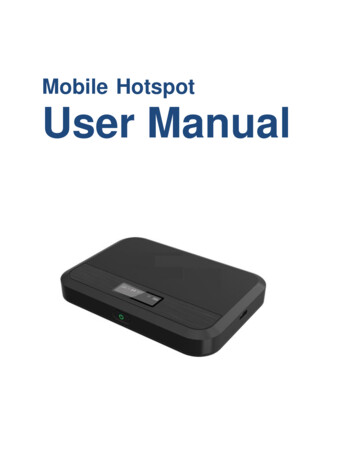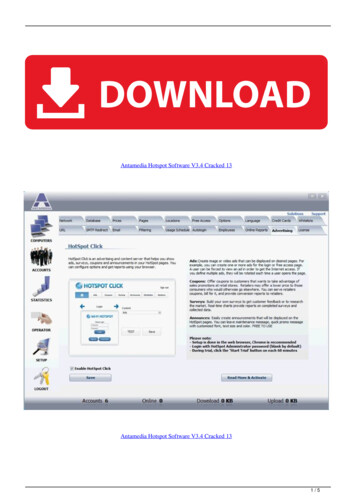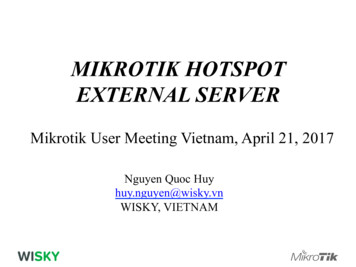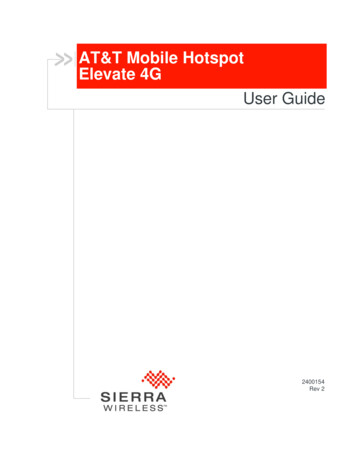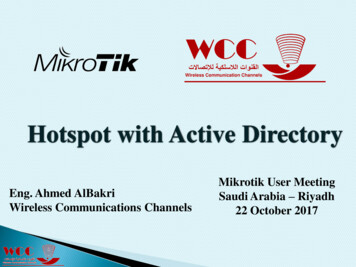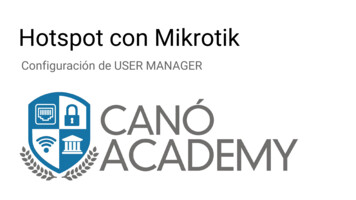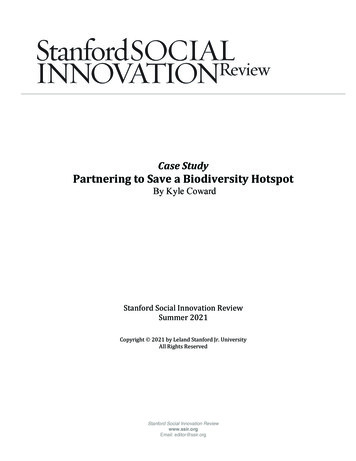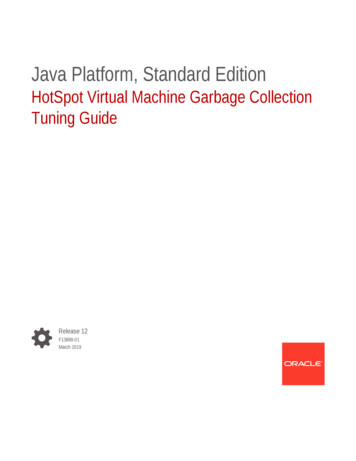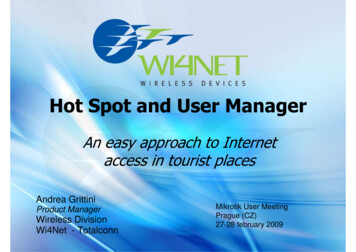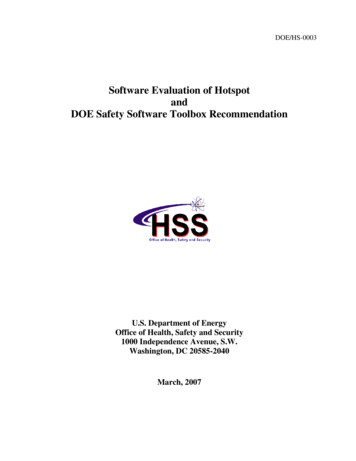
Transcription
DOE/HS-0003Software Evaluation of HotspotandDOE Safety Software Toolbox RecommendationU.S. Department of EnergyOffice of Health, Safety and Security1000 Independence Avenue, S.W.Washington, DC 20585-2040March, 2007
ForewordThis report documents the outcome of an evaluation of the Safety Software Quality Assurance(SSQA) attributes of Hotspot, a health physics application, relative to the safety softwarerequirements identified in DOE O 414.1C, Quality Assurance. This evaluation, a “gap analysis”,is performed according to the implementation guide DOE G 414.1-4, and is a requisite fordeciding whether Hotspot should be designated as a toolbox code for DOE’s safety softwareCentral Registry. Comments regarding this document should be addressed to:Debra R. SparkmanU.S. Department of Energy1000 Independence Avenue, S.W.Washington, D.C. 20585-2040(202) 586-3947debra.sparkman@hq.doe.govii
ContentsEXECUTIVE SUMMARY .V1INTRODUCTION. 11.11.21.31.4OBJECTIVES. 1DESCRIPTION OF HOTSPOT. 1SOFTWARE TYPE AND GRADE LEVEL DESIGNATION . 3EVALUATION PROCESS . 42HOTSPOT SUMMARY . 43REVIEW OF HOTSPOT WORK ACTIVITIES . 9.33.9.4SOFTWARE PROJECT MANAGEMENT AND QUALITY PLANNING . 6Work Activity Evaluation and Results. 7Sources and Method of Review. 7Software Quality Assurance-Related Issues or Concerns. 7Recommendations . 7SOFTWARE RISK MANAGEMENT . 9Work Activity Evaluation and Results. 10Sources and Method of Review. 10Software Quality Assurance-Related Issues or Concerns. 10Recommendations . 10SOFTWARE CONFIGURATION MANAGEMENT . 12Work Activity Evaluation and Results. 12Sources and Method of Review. 12Software Quality Assurance-Related Issues or Concerns. 12Recommendations . 12PROCUREMENT AND SUPPLIER MANAGEMENT . 14Work Activity Evaluation and Results. 14Sources and Method of Review. 14Software Quality Assurance-Related Issues or Concerns. 14Recommendations . 15SOFTWARE REQUIREMENTS IDENTIFICATION AND MANAGEMENT . 16Work Activity Evaluation and Results. 16Sources and Method of Review. 16Software Quality Assurance-Related Issues or Concerns. 16Recommendations . 16DESIGN AND IMPLEMENTATION . 18Work Activity Evaluation and Results. 19Sources and Method of Review. 19Software Quality Assurance-Related Issues or Concerns. 19Recommendations . 19SOFTWARE SAFETY . 21Work Activity Evaluation and Results. 21Sources and Method of Review. 22Software Quality Assurance-Related Issues or Concerns. 22Recommendations . 22VERIFICATION AND VALIDATION . 22Work Activity Evaluation and Results. 23Sources and Method of Review. 23Software Quality Assurance-Related Issues or Concerns. 23Recommendations . 23PROBLEM REPORTING AND CORRECTIVE ACTION . 25Work Activity Evaluation and Results. 25Sources and Method of Review. 25Software Quality Assurance-Related Issues or Concerns. 25Recommendations . 26iii
DOE/HS-00033.10TRAINING PERSONNEL IN THE DESIGN, DEVELOPMENT, USE, AND EVALUATION OF SAFETYSOFTWARE . 263.10.1Work Activity Evaluation and Results. 273.10.2Sources and Method of Review . 273.10.3Software Quality Assurance-Related Issues or Concerns . 273.10.4Recommendations . 283.11MODEL VALIDATION/PERFORMANCE . 293.11.1Work Activity Evaluation and Results. 293.11.2Sources and Method of Review . 293.11.3Software Quality Assurance-Related Issues or Concerns . 303.11.4Recommendations . 314CONCLUSIONS AND RECOMMENDED ACTIONS . 31APPENDIX A. DOCUMENTS REVIEWED . A-1APPENDIX B. ROLES OF INDIVIDUALS INTERVIEWED. B-1APPENDIX C. DEFINITIONS. C-1APPENDIX D. ACRONYMS . D-1APPENDIX E. REFERENCES . E-1APPENDIX F. EVALUATION TEAM BIOGRAPHIES.F-1iv
Executive SummaryThe development and maintenance of a collection, or “toolbox,” of high-use, Department ofEnergy (DOE) Safety Software Quality Assurance (SSQA)-compliant codes is one of the majorimprovement actions supported under DOE O 414.1C Quality Assurance and DOE G 414.1-4,Safety Software Guide for Use with 10 CFR 830 Subpart A, Quality Assurance Requirements, andDOE O 414.1C Quality Assurance. Hotspot Health Physics Codes (referred to as Hotspot) V 2.07and all future minor releases are being considered for the DOE Safety Software Central Registry.To evaluate Hotspot’s compliance with SSQA requirements, a software-specific gap analysis isnecessary. SSQA requirements are those documented in DOE O 414.1C. The gap analysisevaluates the SSQA attributes against the identified work activities specified in DOE O 414.1Cand DOE G 414.1-4. The evaluation documented herein provides the results of the gap analysisfor Hotspot versions specified above and also recommends whether these products and versionsshould be added to the DOE’s Safety Software Central Registry.Based on the outcome of the gap analysis, Hotspot version V 2.07 and all future minor releasesare recommended for inclusion in the DOE Safety Software Central Registry contingent upon thefive critical recommendations being implemented by Lawrence Livermore National Laboratory.Of the eleven work activities evaluated for Hotspot, one work activity was fully met, eight werepartially met, and two were not met.Five work activities (software configuration management, verification and validation, problemreporting and corrective action, training, and model validation/performance) include criticalrecommendations that if implemented properly will increase the level of compliance for thosework activities to acceptable quality levels. It is recommended that the following Hotspotimprovement actions be taken prior to inclusion into the Central Registry:CritRec 1.CritRec 2.CritRec 3.CritRec 4.CritRec 5.R3-1 Prompt development and implementation of a formal configurationmanagement plan that documents the process to be followed in providingconfiguration management for the Hotspot program. This includes documentationfor the version control system, software storage, software back-up and disasterplanning. Critical to the configuration management implementation is a baselinelabeling system that addresses major and minor releases and the establishment of aformal change control process that identifies proposed enhancements and potentialdefects.R8-1: Plan, implement, and document the V&V test processes. The test processesshould include both developer-level testing (component, integration, and system)as well as the acceptance testing already performed through the QC method.R9-1: Establish, implement and documented a problem reporting, evaluation andnotification process consistent with the guidance in DOE G 414.1-4 for level Bcustom software.R10-1: Promptly complete and issue the Hotspot User Manual and online helpmodules for V 2.07 with awareness that these resources are the primary sources foruser training.R11-1: Implement a method to read meteorological input data files to satisfy the95th-percentile dose requirement of DOE-STD-3009-94 Change Notice 3 AppendixA, subsection A.3.3 Dose Estimation / Atmospheric Dispersion.v
DOE/HS-0003The evaluation team has seventeen additional recommendations that should be considered asfuture improvements for Hotspot and its software processes. These recommendations as well asthe critical recommendations are included in each work activity section in this document andsummarized in Section 4. Conclusions and Recommended Actions.vi
DOE/HS-00031IntroductionThe development and maintenance of a collection, or “toolbox,” of high-use, Department of Energy(DOE) Safety Software Quality Assurance (SSQA)-compliant codes is one of the major improvementactions supported under DOE O 414.1C Quality Assurance and DOE G 414.1-4, Safety Software Guidefor Use with 10 CFR 830 Subpart A, Quality Assurance Requirements, and DOE O 414.1C QualityAssurance. Hotspot Health Physics (referred to as Hotspot) V 2.07 and all future minor releases arebeing considered for the DOE Safety Software Central Registry.To evaluate Hotspot’s compliance with SSQA requirements, a software-specific gap analysis isnecessary. SSQA requirements are those documented in DOE O 414.1C. The gap analysis evaluates theSSQA attributes against the identified work activities specified in DOE O 414.1C and DOE G 414.1-4.The evaluation documented herein provides the results of the gap analysis for Hotspot versions specifiedabove and also recommends whether these products and versions should be added to the DOE’s SafetySoftware Central Registry.1.1ObjectivesThe intent of the gap analysis is to evaluate Hotspot specified above and recommend to the DOE Officeof Health, Safety and Security (HSS) whether this safety software should be added to the DOE SafetySoftware Central Registry.1.2Description of HotspotHotspot, developed by Lawrence Livermore National Laboratory (LLNL), was created to provideemergency response personnel and emergency planners with a fast, field-portable set of software toolsfor evaluating incidents involving radioactive material. The software is also used for safety-analysis ofDOE facilities handling nuclear material. Hotspot provides a fast and usually conservative means forestimation the radiation effects associated with the short-term (less than 24 hours) atmospheric release ofradioactive materials1.Hotspot incorporates Federal Guidance Reports 11, 12, and 13 (FGR-11, FGR-12, FGR-13) DoseConversion Factors (DCFs) for inhalation, submersion, and ground shine. FGR-12 DCF values are usedfor submersion and ground shine. In addition to the inhalation 50-year Committed Effective DoseEquivalent DCFs, acute (1, 4, 30 days) DCFs are available for estimating deterministic effects. Thisacute mode can be used for estimating the immediate radiological impact associated with high acuteradiation doses (applicable target organs are the lung, small intestine wall, and red bone marrow).Hotspot was originally developed in 1985 for deployment for a Hewlett Packard HP-41 system. HotspotV 2.0 through V 8.0 were Microsoft (MS) DOS-based using Borland Turbo Pascal. In 1999, Hotspot(referred to as Hotspot 98) underwent a significant rewrite in MS Visual Basic V6.0 for the MSWindows 95/98/XP environment. In 2002, Hotspot V2.0 was issued. Throughout the development ofHotspot, new functionality and radionuclides were included. The Hotspot development process has beeninformal and not developed for compliance to nuclear industry consensus standards.To be considered for inclusion into DOE Safety Software Central Registry as a toolbox code, softwaremust meet basic criteria. Table 1-1 provides a summary of the justification for Hotspot toward meeting1Hotspot Health Physics Codes web site, http://www.llnl.gov/nhi/hotspot//.1
DOE/HS-0003these basic criteria.Table 1-1. Justification for Adding Hotspot to DOE Safety Software Central RegistryCriterionJustificationWidespread use of the software across DOE complexfor safety related applications.Hotspot is currently used for radiological emergencyresponse planning at most (if not all) DOE sites.Hotspot is routinely used by DOE and contractorpersonnel “to perform calculations and develop dataused to establish the safety basis for DOE facilitiesand operations, and to support the variety of safetyanalyses and safety evaluations developed for thesefacilities.”Meets definition of safety software from DOE O414.1C.Hotspot fits the safety and Hazard Analysis Softwareand Design Software definition of safety softwarespecified in DOE O 414.1C2.(1) Safety System Software. Software for a nuclearfacility that performs a safety function as part of astructure, system, or component and is cited in either(a) a DOE approved documented safety analysis or(b) an approved hazard analysis per DOE P 450.4,Safety Management System Policy, dated 10-15-96,and the DEAR clause.(2) Safety and Hazard Analysis Software and DesignSoftware. Software that is used to classify, design, oranalyze nuclear facilities. This software is not part ofa structure, system, or component (SSC) but helps toensure the proper accident or hazards analysis ofnuclear facilities or an SSC that performs a safetyfunction.(3) Safety Management and Administrative ControlsSoftware. Software that performs a hazard controlfunction in support of nuclear facility or radiologicalsafety management programs or technical safetyrequirement or other software that performs a controlfunction necessary to provide adequate protectionfrom nuclear facility or radiological hazards. Thissoftware supports eliminating, limiting, or mitigatingnuclear hazards to workers, the public, or theenvironment as addressed in 10 CFR 830, 10 CFR835, and the DEAR ISMS clause.Demonstrated and quantifiable benefit fordesignating the software to the Central Registry.2SCAPA has received numerous inquiries from DOEsites about the software quality assurance (SQA)status of Hotspot and the appropriateness of usingHotspot for safety analyses. Currently, none of thecodes in the Central Registry is designed to bebroadly applicable for radiological safety planning atDOE sites. EPICode and ALOHA are broadlyapplicable and technically comparable to Hotspot,but these two models only assess non-radiologicalhazards. Other models are designed to assess routineradiological releases or only releases fromspecialized facilities (e.g., nuclear reactors). There istherefore a huge gap in the current coverage ofDOE’s Safety Software Central Registry toolboxGlantz, Clifford, Justification for Hotspot Inclusion to DOE Safety Software Central Registry, July 21, 2006.2
DOE/HS-0003Criterion1.3Justificationcodes. The cost for DOE sites to independentlyperform SQA work activities on Hotspot isconsiderable. The cost-effective course of action isfor the LLNL developers and custodians of Hotspotto work with the DOE to perform any required SQAupgrades or testing of Hotspot, add Hotspot to theCentral Registry, and allow all of the DOE sites touse Hotspot without having to individually repeat anextensive and expensive SQA testing program.Software Type and Grade Level DesignationAs specified in DOE G 414.1-4, current and potential safety software Central Registry software is bestdescribed under the custom developed category. Criteria for evaluation of Hotspot should be consistentwith the graded approach for custom developed software.Hotspot is a critical component in the safety analysis for DOE nuclear facilities as well as first responderapplication in formulating protective actions and preparing Emergency Planning Hazards Assessments(EPHAs). On the basis of DOE G 414.1-4 and the information received in the DOE survey on Hotspotuse and application, a Hotspot failure could result in incorrect analysis of hazardous exposures toworkers or the public. Therefore, as Hotspot is used for DOE safety analysis applications, the Level Bsoftware grade level is justified (Table 1-2).Table 1-2. Software Grade Level ConfirmationSoftware LevelCheck all thatapplyA. This grading level includessafety software applications thatmeet one or more of thefollowing criteria.Criteria for Grading LevelSoftware failure that could compromise a limiting condition foroperation.Software failure that could cause a reduction in the safety marginfor a safety system, structure or component (SSC) that is cited inDOE approved documented safety analysis.Software failure that could cause a reduction in the safety marginfor other systems such as toxic or chemical protection systemsthat are cited in either: (a) DOE approved documented safetyanalysis or, (b) an approved hazard analysis per DOE P 450.1Safety Management System Policy and the DEAR ISMS clause.Software failure that could result in non-conservative safetyanalysis, design or misclassification of facilities or SSCsB. This grading level includessafety software applications thatdo not meet Level A criteria butmeet one or more of thefollowing criteria.Safety management databases used to aid in decision makingwhose failure could impact safety SSC operation. Software failure that could result in incorrect analysis, design,monitoring, alarming, or recording of hazardous exposures toworkers or the public.Software failure that could compromise the defense in depthcapability for the nuclear facility.C. This grading level includessoftware applications that do notmeet Level B criteria but meetone or more of the followingSoftware failure that could cause a potential violation ofregulatory permitting requirements.Software failure that could affect environment, safety, healthmonitoring or alarming systems.3
DOE/HS-0003Software LevelCheck all thatapplycriteria.1.4Criteria for Grading LevelSoftware failure that could affect the safe operation of an SSCEvaluation ProcessThe evaluation process is initiated by the software sponsor and led by the software evaluator (Table 1-3).Descriptions of these roles and their responsibilities are included in DOE G 414.1-4 Appendix B. Theevaluation focuses on 11 work activities. Work Activities 1 - 10 are those defined in DOE O 414.1C.The Central Registry evaluation process adds an eleventh work activity to address modelvalidation/performance. The graded approach, as specified in DOE G 414.1-4, is applied to the workactivities (Table 1-4), with work activity 11, required to be fully met. The term Full implies that allelements of the work activity must be addressed. The term Grade allows some elements of the workactivity to be optional or implemented with less rigor. A list of documents reviewed is contained inAppendix A of this report. The roles of individuals interviewed during this evaluation are listed inAppendix B.Table 1-3. Contact Information for Hotspot Sponsor and EvaluatorSponsorClifford S. Glantz, SCAPA ChairPacific Northwest National LaboratoryPO Box 9993200 Q StreetRichland, WA 99352(509) 375-2166cliff.glantz@pnl.govEvaluatorDebra R. SparkmanU.S. Department of Energy1000 Independence Avenue, S.W.Washington, D.C. 20585-2040(202) 586-3947debra.sparkman@hq.doe.govTable 1-4. Work Activities and Applicability of DOE G 414.1-4 Criteria for Hotspot Products2Work ActivityApplicability1. Software project management and quality planningFull2. Software risk managementGrade3. Software configuration managementFull4. Procurement &supplier managementFull5. Software requirements identification & managementFull6. Software design & implementationFull7. Software safetyGrade8. Verification and validationGrade9. Problem reporting & corrective actionFull10. Training personnel in the design, development, use, andevaluation of safety softwareGrade11. Model validation/performanceFullHotspot SummaryThe gap analysis of Hotspot considered a body of information that describes the code and itsdevelopment, characteristics, strengths, operating parameters, and other pertinent information. Detailedbelow is a general overview of Hotspot (Table 2-1).4
DOE/HS-0003Table 2-1. Overview of HotspotTypeSpecific InformationVersion(s) of HotspotV2.05, V2.06, and V2.07 (Beta)Developing Organizations and SponsorInformationNational Atmospheric Release Advisory CenterLawrence Livermore National LaboratoryP.O. Box 808, L-103Livermore, CA 94551, USAAuxiliary Software ProductsFIDLER- a tool for calibrating radiation survey instruments for groundsurvey measurements and initial screening of personnel for possibleplutonium uptake in the lung.Nuclear Explosion to estimate the effects of a surface-burst nuclearweapon.Radionuclides in the Workplace – Guide for initial planning ofexperimental and workplace selection.Software Platform/PortabilityMS Windows 95/98/XPProgramming Languages & ToolsMS Visual Basic V6.0, Macromedia RoboHelp X5Technical Support Point of ContactSteve HomannLawrence Livermore National Laboratoryshomann@llnl.govCode Procurement Point of ContactSteve HomannLawrence Livermore National hotspot/Code Package Label/TitleHotspot V 2.0xContributing Organization(s)N/ARecommended Documentation Supplied with Code Transmittal uponDistribution or Otherwise AvailableUser documentation is included with software distribution. Hotspot V2.07 includes a separate users’ manual.Input Data/Parameter RequirementsSource term (material at risk, release fractions, etc.), meteorology(stability class, wind speed, etc), sample time, deposition velocity,receptor distance.Summary of OutputDose (CEDE or TEDE), concentration, deposition, ground shine doserate, and plume arrival time; all as a function of input receptor distance.Nature of Problem Addressed bySoftwareSafety analysis and consequence assessment for DOE nuclear facilities.Significant Strengths of SoftwareEasy to use, reliable, and conservative. The model is widely usedthroughout the DOE complex and has an excellent reputation.Known Restrictions or LimitationsRelies on simple straight-line plume modeling assumptions that do notaccount for spatial or temporal variations in meteorological conditions orother complex atmospheric dispersion processes. While Hotpot may besimplistic, it produces results that are conservative.Preprocessing (set-up) time for TypicalSafety Analysis CalculationMinimalExecution TimeSecondsComputer Hardware RequirementsWindows capable computersComputer Operating SystemRequirementsWindows 95/98/XP5
DOE/HS-0003TypeSpecific InformationOther Associated Software ProductsFor emergency response applications, Hotspot interfaces with theNational Atmospheric Release Advisory Center (NARAC) models whichprovide more sophisticated modeling capabilities that include complexterrain and multi-location real-time wind field data.3Review of Hotspot Work ActivitiesDetails on the evaluation process relative to requirements and criteria that are met in compliance withDOE G 414.1-4, are covered in sections 3.1 through 3.11 of this report. The review method consisted ofreviewing specific work activity criteria against the information contained in documentation as identifiedin each of the eleven sections.The work activities for Hotspot should be evaluated based upon the graded level of the safety software and theapplicable software type. In the tables that follow, five qualitative values shall be used to evaluate whether aspecific criterion is met: 3.1Yes – evidence is available to confirm that the program, practices, and/or procedures followed indeveloping the software satisfy the criterion.No – sufficient evidence does not exist to demonstrate the criterion is metPartial – some evidence exists that the criterion is met, but has not been finalized or isincompleteUncertain – no basis is available to confirm that the criterion is metN/A - the requirement is not applicable.Software Project Management and Quality PlanningProject management and quality planning establish the foundation to ensure that a quality product isdeveloped and maintained. Software-specific tasks associated with the completion of the software
Hotspot Health Physics Codes (referred to as Hotspot) V 2.07 and all future minor releases are being considered for the DOE Safety Software Central Registry. To evaluate Hotspot's compliance with SSQA requirements, a software-specific gap analysis is necessary. SSQA requirements are those documented in DOE O 414.1C. The gap analysis
